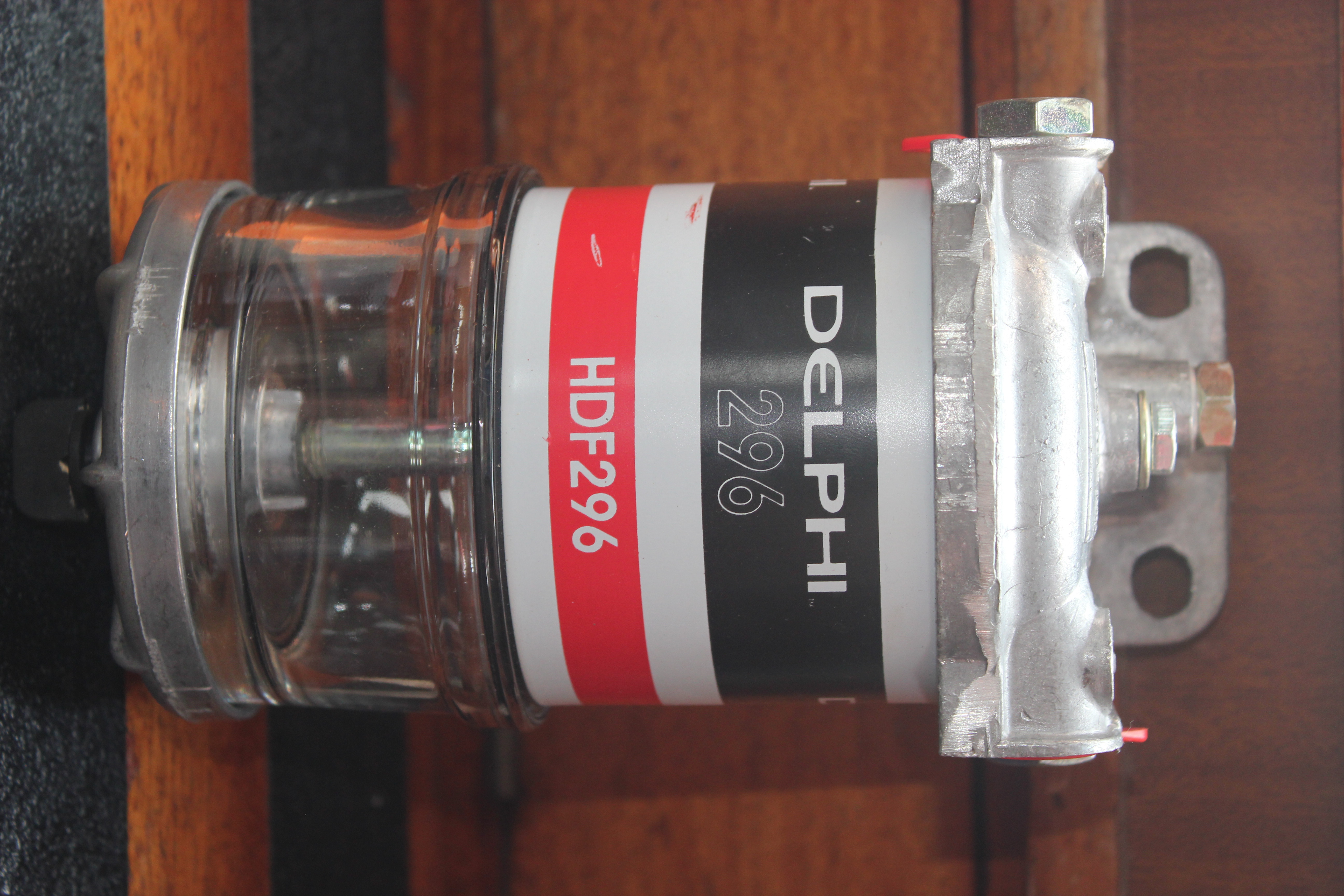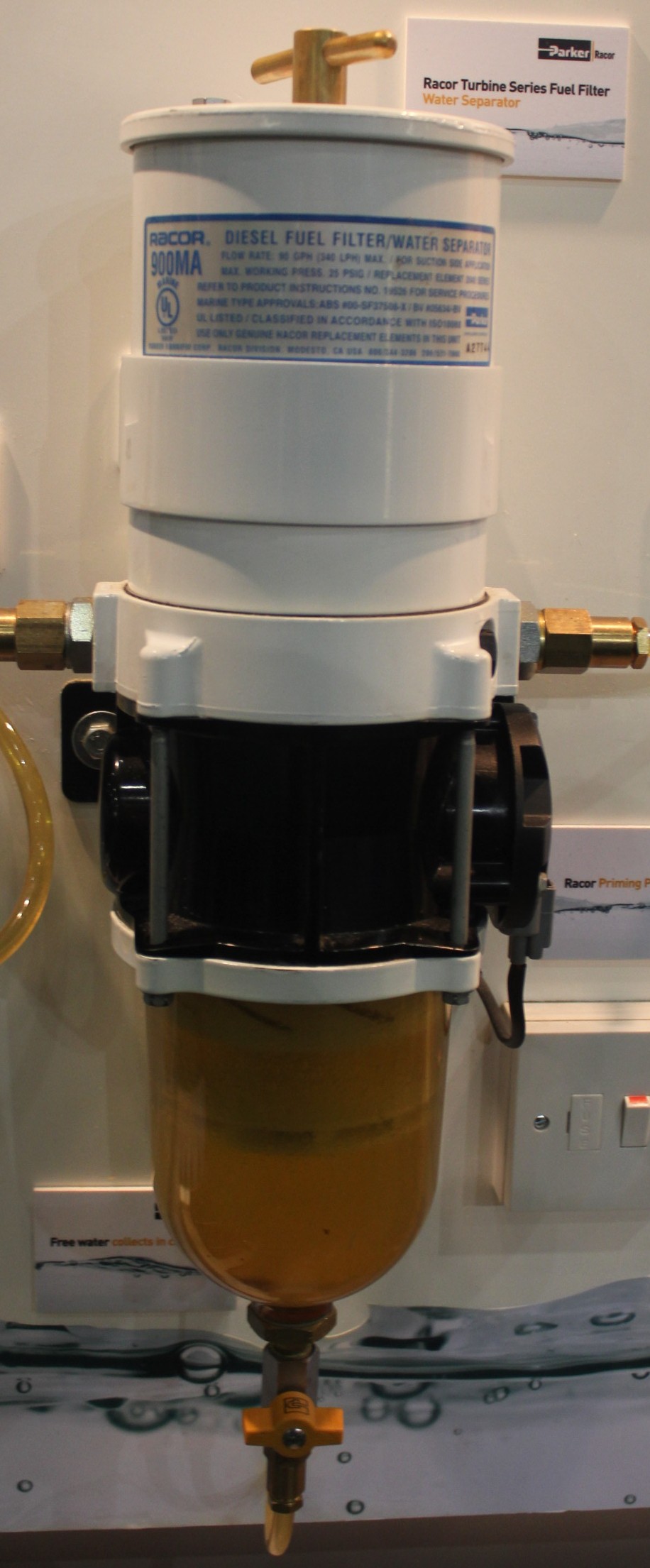Fuel Filters for Diesel Engines
Fuel filters for diesel engines are fundamental for reliable diesel engine operation on a sailing yacht which depends heavily on clean fuel. Marine diesel tanks are vulnerable to contamination from water, microbial growth (“diesel bug”), rust, and various particulate matter introduced during refueling or from tank degradation. Because even small quantities of contaminants can clog injectors and stop an engine at the worst possible moment, robust fuel filtration is essential.
Most small marine diesel installations, especially cruising yachts, use a dual-filter system consisting of a primary fuel filter/water separator and a secondary engine-mounted filter. This article focuses on the primary filters typically used in small marine systems, including CAV/Delphi-style filters and Racor turbine filters, and examines the types of filter elements used in these installations.
Fuel Filters for Diesel Engines
– Primary Filters
The primary filter is the first line of defense between the fuel tank and the engine’s lift pump. Its functions include:
- Removing water, which is common in marine environments due to condensation and fuel transfer.
- Separating particulates, including rust flakes, grit, and microbial debris.
- Providing a sediment bowl, allowing visual inspection of water or dirt accumulation.
- Protecting the finer secondary filter mounted on the engine.
Primary filters are typically rated between 2 and 30 microns, depending on the system design. The engine's secondary filter is usually a fine element rated between 2 and 10 microns, so the primary filter is selected to trap larger contaminants without restricting fuel flow
CAV / Delphi-Type
Filters
CAV (Cleveland Auto Vacuum) filters, now manufactured under Delphi and other brands, are among the most common primary filters found on older or traditionally outfitted yachts. Their popularity stems from low cost, worldwide availability, and simple construction. They are also referred to as agglomerators. Construction and Operation. A typical CAV/Delphi filter assembly consists of:
- A cast metal filter head
- A replaceable paper element
- A glass or plastic sediment bowl
- A central bolt and seals
Fuel enters the outer part of the canister, flows through the pleated paper element, and exits through the filter head. Water and heavy particles settle into the bowl. The advantages are that they have an inexpensive replacement elements, are widely available, even in remote cruising areas, have a clear sediment bowl facilitates inspection. The disadvantages are they can be prone to air leaks if seals are not seated properly, more messy and labor-intensive to change, no integrated priming pump
Filter Elements. CAV/Delphi elements (often referenced as 296 filters) are available in different micron ratings, though 5–10 micron is common for primary use. They consist of pleated cellulose or synthetic paper media.
Delphi “HDF” Series. Delphi also produces improved versions of the CAV design, such as the HDF296 and HDF296-11, incorporating modern filter media and better water separation. These are direct replacements in most CAV-style heads but offer higher water-holding capacity, better particulate filtration, and more durable anti-collapse structures. These features make them popular with owners who want CAV compatibility without sacrificing performance. The Delphi HDP (High-Density Polymeric) fuel filter works by directing fuel through a multilayer synthetic filter element designed for high water separation and particulate capture. Fuel enters the housing, where heavier contaminants and water settle in the bowl. The remaining fuel passes through the dense polymeric media, which traps fine particles while repelling water. Clean fuel exits the outlet, while accumulated water can be drained from the bowl. This design provides efficient filtration, durability, and stable performance under marine vibration.
Racor Turbine
Filters
Racor (a division of Parker Hannifin) is the benchmark for high-performance marine diesel filtration. Their turbine series, such as the Racor 500 and Racor 900 are widely used on cruising and offshore yachts. Racor turbine filters use a three-stage process:
- Centrifugal separation. Incoming fuel is spun, causing water and heavy solids to drop into the bowl.
- Coalescing filtration. A conical filter pack allows smaller water droplets to coalesce and settle.
- Final particulate filtration. A replaceable cartridge element provides micron-rated fuel polishing.
- Clear bowls allow visual inspection and can be equipped with drain valves or water-in-fuel sensors.
Advantages are exceptional water separation efficiency (>95% in many models), high flow capacity, easy cartridge replacement, optional vacuum gauges help diagnose clogging, durable marine-grade construction. Disadvantages are more expensive than CAV/Delphi types, they have a much larger footprint, filter elements cost more.
Filter Elements. Racor elements come in three color-coded micron ratings:
30 micron (Red) – Primary, general-purpose
10 micron (Blue) – Fine primary or secondary
2 micron (Brown) – Secondary or polishing
Many yacht installations use 30 micron Racor elements as the primary stage.
Dual or Duplex
Primary Filter Installations
Many sailing yachts, especially those voyaging offshore, use dual (side-by-side) primary filters. These may be either Parallel “duplex” Filters with a selector valve that allows switching filters while the engine is running. Series filtration systems have a coarse filter (30 micron) followed by a finer filter (10 micron). The duplex arrangement is preferable for long-distance cruising because it avoids engine shutdown in the event of sudden contamination such as when rough seas stir up tank sludge.
Common configurations include: Dual CAV/Delphi heads with manual selector valves. Dual Racor 500s with an integrated manifold. A mixed system, such as a Racor for coarse separation followed by a Delphi filter
Filter Element
Materials
Filter elements in marine diesel primary filters are typically made from:
- Cellulose (paper). These are inexpensive; sufficient for most applications; and less efficient with water.
- Synthetic fibers. These have better water resistance, higher dirt-holding capacity, stable under vibration.
- Aquabloc® (Racor proprietary). Multilayer synthetic media with excellent water separation.
Fuel Filters for Diesel Engines
Fuel filtration is a critical part of small marine diesel reliability. Whether using affordable CAV/Delphi units or premium Racor turbine assemblies, yachts must maintain clean fuel through proper primary filtration. Understanding the differences in filter types, media, and installation strategies allows sailors to tailor systems that match their cruising style, reliability expectations, and budget. Regular inspection, timely cartridge replacement, and awareness of water contamination are essential to ensuring that the engine fires up when it matters most, whether entering a tight harbor, motoring through a channel, or maneuvering in challenging conditions. Fuel filters for diesel engines are critical path items.


